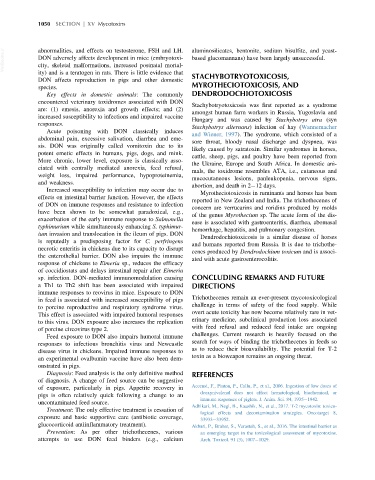Page 1118 - Veterinary Toxicology, Basic and Clinical Principles, 3rd Edition
P. 1118
1050 SECTION | XV Mycotoxins
VetBooks.ir abnormalities, and effects on testosterone, FSH and LH. aluminosilicates, bentonite, sodium bisulfite, and yeast-
based glucomannans) have been largely unsuccessful.
DON adversely affects development in mice (embryotoxi-
city, skeletal malformations, increased postnatal mortal-
ity) and is a teratogen in rats. There is little evidence that STACHYBOTRYOTOXICOSIS,
DON affects reproduction in pigs and other domestic
MYROTHECIOTOXICOSIS, AND
species.
Key effects in domestic animals: The commonly DENDRODOCHIOTOXICOSIS
encountered veterinary toxidromes associated with DON
Stachybotryotoxicosis was first reported as a syndrome
are: (1) emesis, anorexia and growth effects; and (2)
amongst human farm workers in Russia, Yugoslavia and
increased susceptibility to infections and impaired vaccine
Hungary and was caused by Stachybotrys atra (syn
responses.
Stachybotrys alternans) infection of hay (Wannemacher
Acute poisoning with DON classically induces
and Wiener, 1997). The syndrome, which consisted of a
abdominal pain, excessive salivation, diarrhea and eme-
sore throat, bloody nasal discharge and dyspnea, was
sis. DON was originally called vomitoxin due to its
likely caused by satratoxin. Similar syndromes in horses,
potent emetic effects in humans, pigs, dogs, and mink.
cattle, sheep, pigs, and poultry have been reported from
More chronic, lower level, exposure is classically asso-
the Ukraine, Europe and South Africa. In domestic ani-
ciated with centrally mediated anorexia, feed refusal,
mals, the toxidrome resembles ATA, i.e., cutaneous and
weight loss, impaired performance, hypoproteinemia,
mucocutaneous lesions, panleukopenia, nervous signs,
and weakness.
abortion, and death in 2 12 days.
Increased susceptibility to infection may occur due to
Myrotheciotoxicosis in ruminants and horses has been
effects on intestinal barrier function. However, the effects
reported in New Zealand and India. The trichothecenes of
of DON on immune responses and resistance to infection
concern are verrucarins and roridins produced by molds
have been shown to be somewhat paradoxical, e.g.,
of the genus Myrothecium sp. The acute form of the dis-
exacerbation of the early immune response to Salmonella
ease is associated with gastroenteritis, diarrhea, abomasal
typhimurium while simultaneously enhancing S. typhimur-
hemorrhage, hepatitis, and pulmonary congestion.
ium invasion and translocation in the ileum of pigs. DON
Dendrodochiotoxicosis is a similar disease of horses
is reputedly a predisposing factor for C. perfringens
and humans reported from Russia. It is due to trichothe-
necrotic enteritis in chickens due to its capacity to disrupt
cenes produced by Dendrodochium toxicum and is associ-
the enterothelial barrier. DON also impairs the immune
ated with acute gastroenterocolitis.
response of chickens to Eimeria sp., reduces the efficacy
of coccidiostats and delays intestinal repair after Eimeria
sp. infection. DON-mediated immunomodulation causing CONCLUDING REMARKS AND FUTURE
a Th1 to Th2 shift has been associated with impaired DIRECTIONS
immune responses to reovirus in mice. Exposure to DON
in feed is associated with increased susceptibility of pigs Trichothecenes remain an ever-present mycotoxicological
to porcine reproductive and respiratory syndrome virus. challenge in terms of safety of the food supply. While
overt acute toxicity has now become relatively rare in vet-
This effect is associated with impaired humoral responses
erinary medicine, subclinical production loss associated
to this virus. DON exposure also increases the replication
with feed refusal and reduced feed intake are ongoing
of porcine circovirus type 2.
challenges. Current research is heavily focused on the
Feed exposure to DON also impairs humoral immune
search for ways of binding the trichothecenes in feeds so
responses to infectious bronchitis virus and Newcastle
as to reduce their bioavailability. The potential for T-2
disease virus in chickens. Impaired immune responses to
toxin as a bioweapon remains an ongoing threat.
an experimental ovalbumin vaccine have also been dem-
onstrated in pigs.
Diagnosis: Feed analysis is the only definitive method REFERENCES
of diagnosis. A change of feed source can be suggestive
of exposure, particularly in pigs. Appetite recovery in Accensi, F., Pinton, P., Callu, P., et al., 2006. Ingestion of low doses of
deoxynivalenol does not affect hematological, biochemical, or
pigs is often relatively quick following a change to an
immune responses of piglets. J. Anim. Sci. 84, 1935 1942.
uncontaminated feed source.
Adhikari, M., Negi, B., Kaushik, N., et al., 2017. T-2 mycotoxin: toxico-
Treatment: The only effective treatment is cessation of
logical effects and decontamination strategies. Oncotarget 8,
exposure and basic supportive care (antibiotic coverage, 33933 33952.
glucocorticoid antiinflammatory treatment). Akbari, P., Braber, S., Varasteh, S., et al., 2016. The intestinal barrier as
Prevention: As per other trichothecenes, various an emerging target in the toxicological assessment of mycotoxins.
attempts to use DON feed binders (e.g., calcium Arch. Toxicol. 91 (3), 1007 1029.

